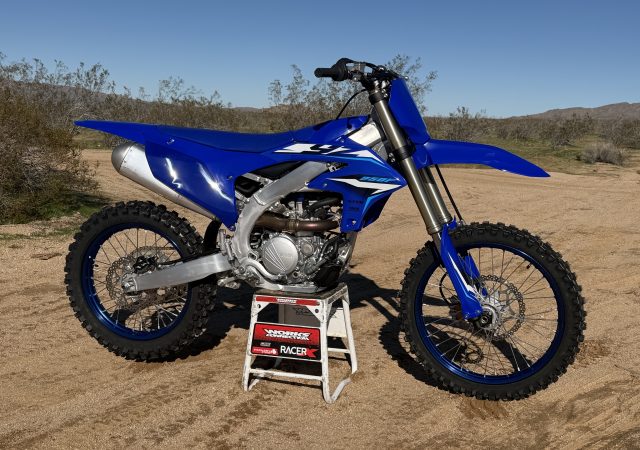
For this edition of Classic Steel, we are going to take a look back at Kawasaki’s all-new KX250 for 2005.
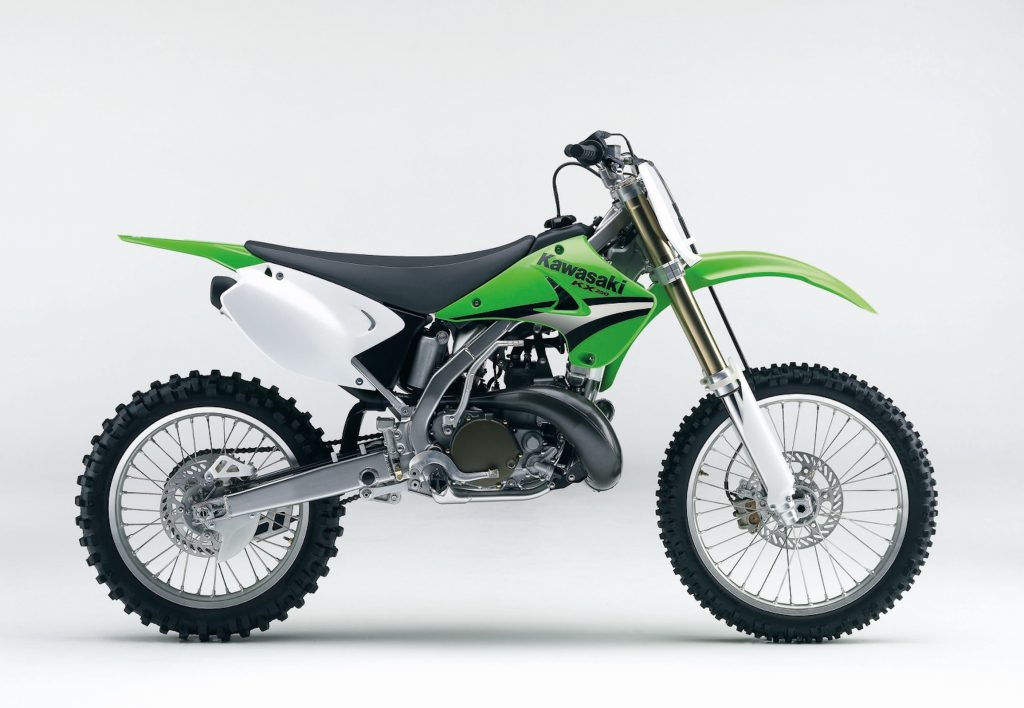 With the two-stroke 250’s era of dominance quickly drawing to a close, Kawasaki threw one last major update at the legendary KX250 in 2005. Photo Credit: Kawasaki
With the two-stroke 250’s era of dominance quickly drawing to a close, Kawasaki threw one last major update at the legendary KX250 in 2005. Photo Credit: Kawasaki
The early 2000s were a bit of a rough patch for Kawasaki’s venerable KX250. After dominating the shootout standings for several years in the late 1990s, the green machines took a major step back in the first years of the new century. Overweight, underpowered, and oversized, the KX250s of the early 2000s were rather disappointing machines.
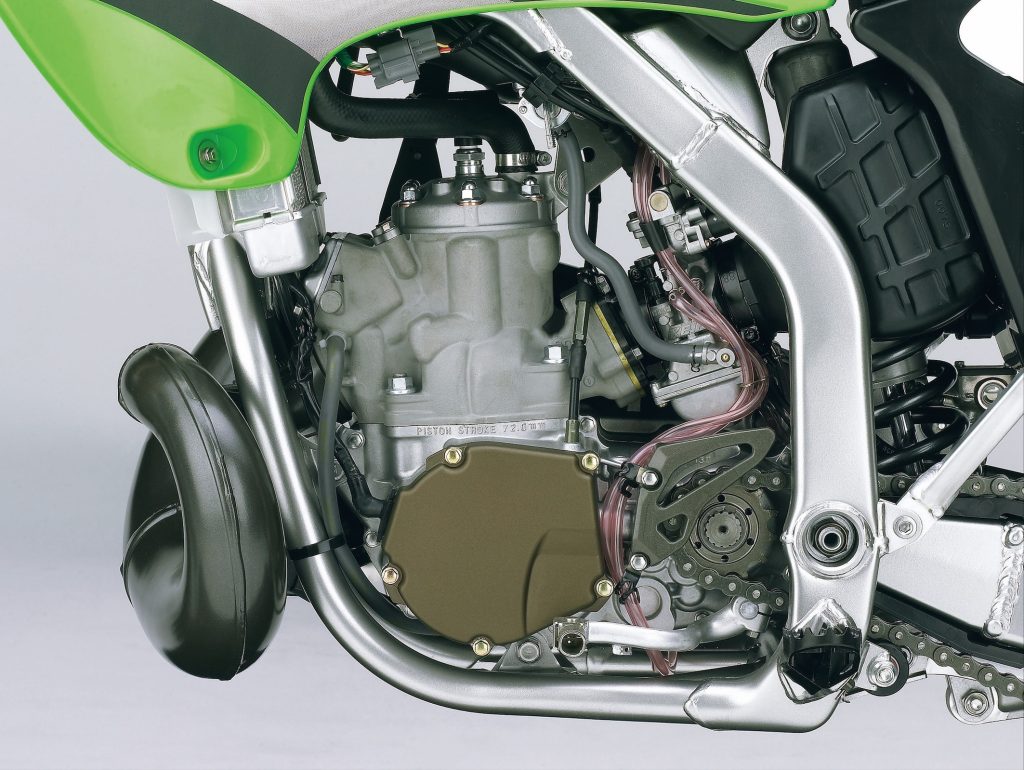 By far the most significant update made to the KX250 in 2005 was the introduction of its all-new 249cc motor. Redesigned from the ground up, the new mill featured a more vertical cylinder placement to shorten the intake tract, extend the exhaust port, and allowed for the use of larger cooling jackets in critical areas. Photo Credit: Kawasaki
By far the most significant update made to the KX250 in 2005 was the introduction of its all-new 249cc motor. Redesigned from the ground up, the new mill featured a more vertical cylinder placement to shorten the intake tract, extend the exhaust port, and allowed for the use of larger cooling jackets in critical areas. Photo Credit: Kawasaki
In 2003, Kawasaki set about righting their 250 fortunes with an all-new 250 machine. The redesigned KX featured an all-new chassis that improved handling, reduced weight, and improved ergonomics. The new machine ditched the Paul Bunyan feel the KX had enjoyed for over a decade in favor of a much more compact layout that felt more in step with the tastes of modern racers. Slim, trim, and with much better handling, the new KX was a major improvement in every category but one. Unfortunately, that one category was power, and here the KX proved a major letdown. Porting, power valve and ignition changes did very little to boost the power output of a motor that could trace its roots back to the first Clinton administration. Pleasant, torquey, and responsive, the KX’s motor was great off-road, but just not up to going toe-to-toe with the 250 class top guns on a motocross circuit.
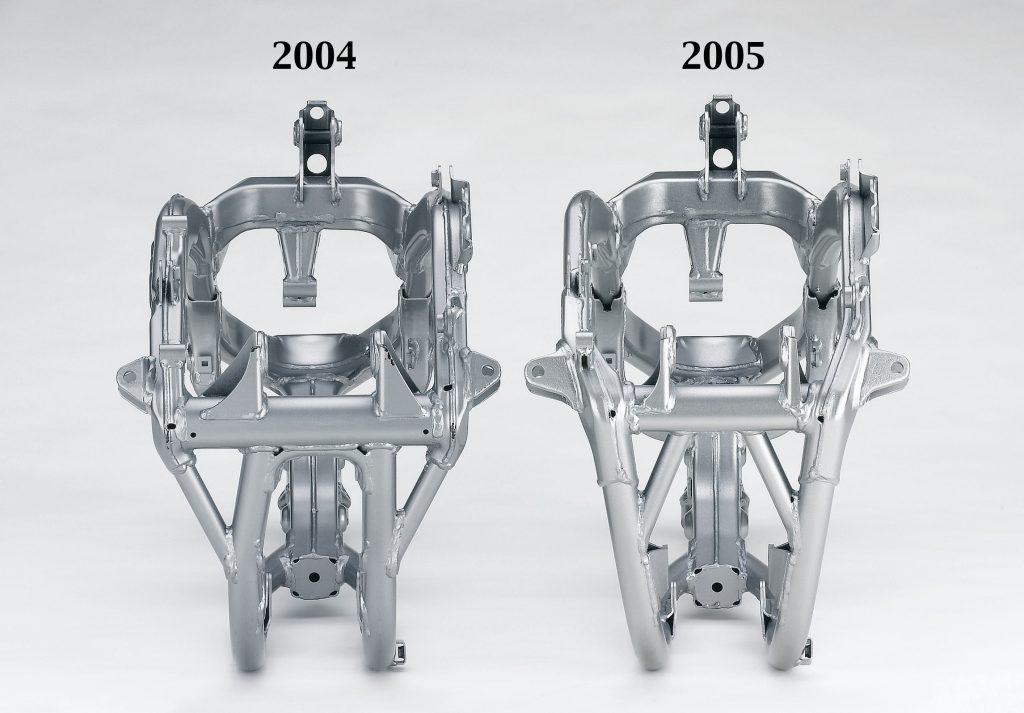 An all-new frame for 2005 maintained the basic layout of 2004 but repositioned the shock mounting, reduced the width of the main spars, and rebalanced the flex characteristics of the chassis to improve handling and feel. Photo Credit: Kawasaki
An all-new frame for 2005 maintained the basic layout of 2004 but repositioned the shock mounting, reduced the width of the main spars, and rebalanced the flex characteristics of the chassis to improve handling and feel. Photo Credit: Kawasaki
For 2004, Kawasaki dialed up another slew of Band-aid fixes for its geriatric motor but none of them did much to improve its firepower on the track. At its peak, it gave up over three horsepower to its competitors and was no match for the broad output of the YZ or instant snap of the RM. Novices and off-road riders enjoyed its mellow delivery, but hard-core motocross racers lamented its lack of hit and non-existent top-end performance.
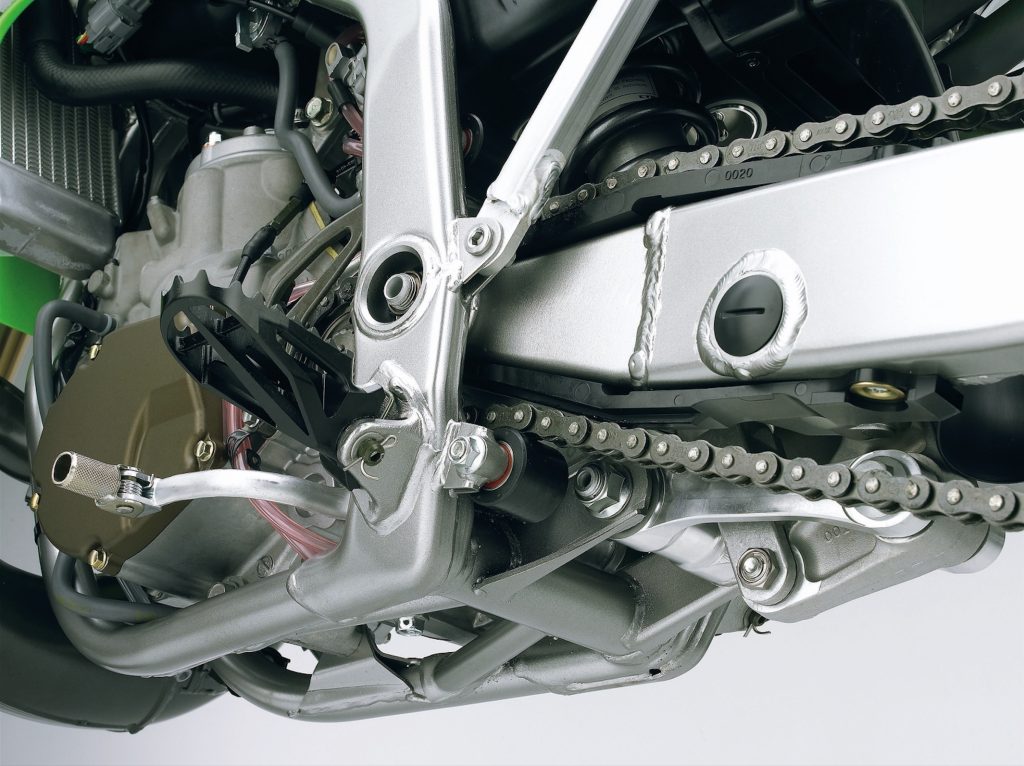 All-new pegs for 2005 were wider and placed higher on the chassis for greater comfort. A new swingarm was added that featured increased stiffness to prevent flex in the rough. This was paired with a redesigned Uni-Trak linkage that offered a revised curve for smoother action. Photo Credit: Kawasaki
All-new pegs for 2005 were wider and placed higher on the chassis for greater comfort. A new swingarm was added that featured increased stiffness to prevent flex in the rough. This was paired with a redesigned Uni-Trak linkage that offered a revised curve for smoother action. Photo Credit: Kawasaki
For 2005, Kawasaki knew that they would need to step up their motor game to have any hope of keeping the KX on the shopping lists of any serious racers. The move to four-strokes was thoroughly underway and the 2004 KX250 had trouble running with other two-strokes and no hope of keeping powerhouses like the YZ450F in sight. With that in mind, Kawasaki threw the full force of their R & D department at the 2005 KX.
 James Stewart’s move to the 250 class in 2005 was one of the most hyped in the sport’s history. His exploits on the 125 had many wondering if a new era of green domination was about to be unleashed on the premier division. While his speed was never in question, Stewart’s inconsistency and propensity for crashing would sidetrack much of his rookie season. Photo Credit: Motocross Action
James Stewart’s move to the 250 class in 2005 was one of the most hyped in the sport’s history. His exploits on the 125 had many wondering if a new era of green domination was about to be unleashed on the premier division. While his speed was never in question, Stewart’s inconsistency and propensity for crashing would sidetrack much of his rookie season. Photo Credit: Motocross Action
First up was a complete redesign of the KX’s engine. The new power plant did not share a single part with the ’04 design aside from its 38mm Keihin Powerjet carburetor. The new motor featured the same 64.4 x 72.0mm bore and stroke and 249cc of displacement as the ’04, but everything else was new. The redesigned cylinder was moved to a more vertical position to allow for a longer exhaust port and larger water jackets. The new top-end featured O-rings for the head gasket to improve sealing and reconfigured porting for improved top-end performance. The piston was new and incorporated special grooves to prevent ring snagging. The KIPS (Kawasaki Integrated Power-valve System) was redesigned and featured a two-stage valve that allowed the main and sub-valves to work independently for a smoother delivery. An all-new intake moved the carburetor closer to the cylinder for increased flow and a redesigned reed valve was added for improved throttle response. A reshaped expansion chamber was bolted on and tuned for more top-end power. The Keihin PWK38S Powerjet carburetor remained and was integrated with an all-new ignition that provided greater condenser capacity and a lighter-weight generator. New jetting specs were added to the carburetor to work with the redesigned power plant and an upgraded throttle cable was installed that offered greater stretch resistance and a smoother feel.
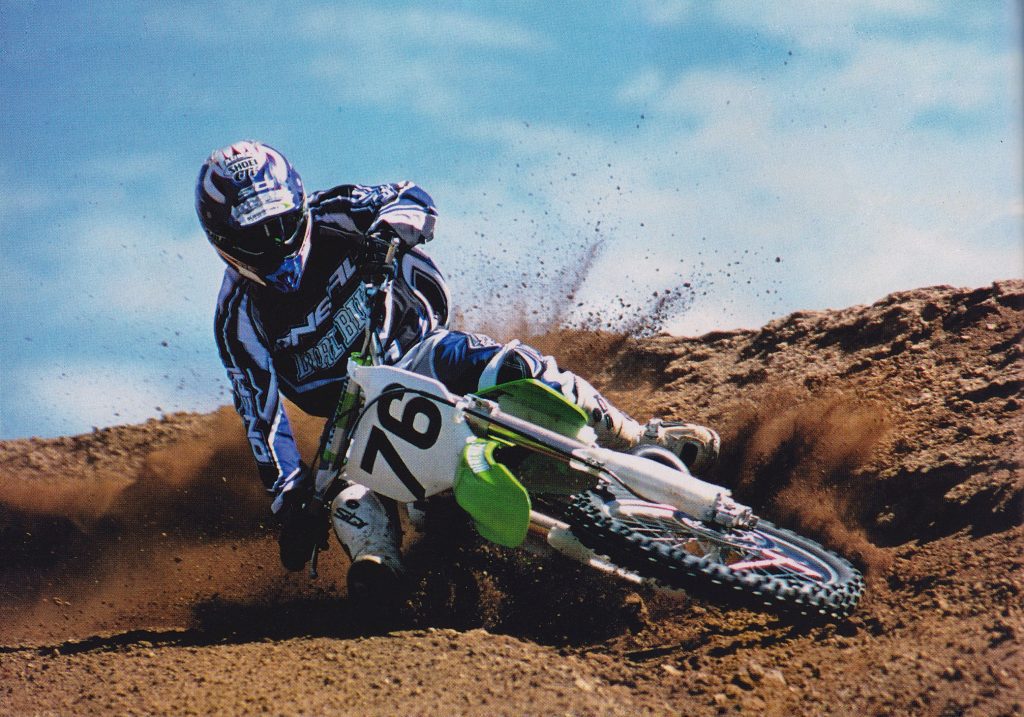 Stable at speed but slightly vague in the turns, the KX was much more comfortable railing the outside line than trying to dive to the inside in 2005. Here off-road hero Destry Abbot demonstrates the KX’s high-speed cornering abilities for Dirt Bike magazine. Photo Credit: Dirt Bike
Stable at speed but slightly vague in the turns, the KX was much more comfortable railing the outside line than trying to dive to the inside in 2005. Here off-road hero Destry Abbot demonstrates the KX’s high-speed cornering abilities for Dirt Bike magazine. Photo Credit: Dirt Bike
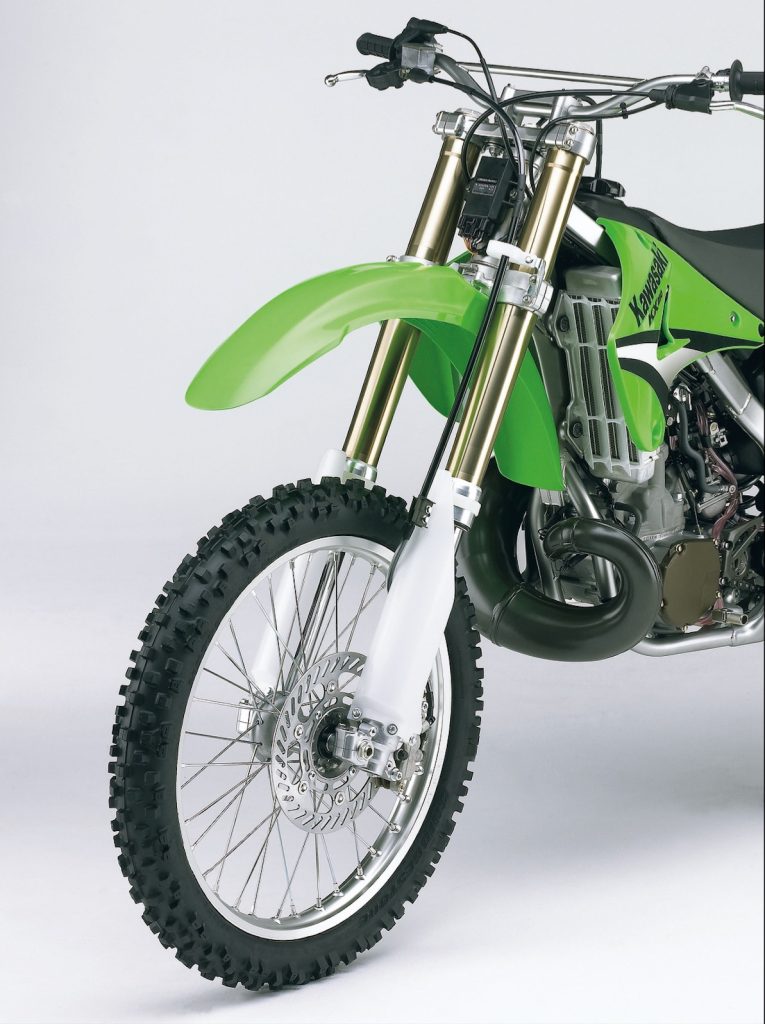 The second most significant update for the KX250 in 2005 was the move to Kayaba’s all-new Air Oil Separation System (AOSS) fork. Similar in concept to Showa’s successful Twin Chamber design, the AOSS promised smother operation and more consistent damping by separating the air and oil chambers of the forks to prevent aeration of the fluid. Photo Credit: Kawasaki
The second most significant update for the KX250 in 2005 was the move to Kayaba’s all-new Air Oil Separation System (AOSS) fork. Similar in concept to Showa’s successful Twin Chamber design, the AOSS promised smother operation and more consistent damping by separating the air and oil chambers of the forks to prevent aeration of the fluid. Photo Credit: Kawasaki
The bottom end of the KX motor was just as new and featured redesigned cases that offered a narrower profile than in 2004. A new crank was installed with a 2mm increase in crank web diameter for improved fuel charging. Engine cooling was improved through the use of an all-new water pump with a revised impeller and new radiators that featured a 20mm increase in core thickness. Inside the transmission, there was a new fifth gear and a redesigned output shaft featuring involute splines for an improved shifting feel. Needle bearings were also added to the shift shaft for smoother performance. A new clutch mechanism repositioned the pivot point to inside the ignition cover and a new Teflon coating was added to the cable to improve the feel. To aid convenience, an “on the fly” adjuster was incorporated into the perch to allow for mid-moto adjustments.
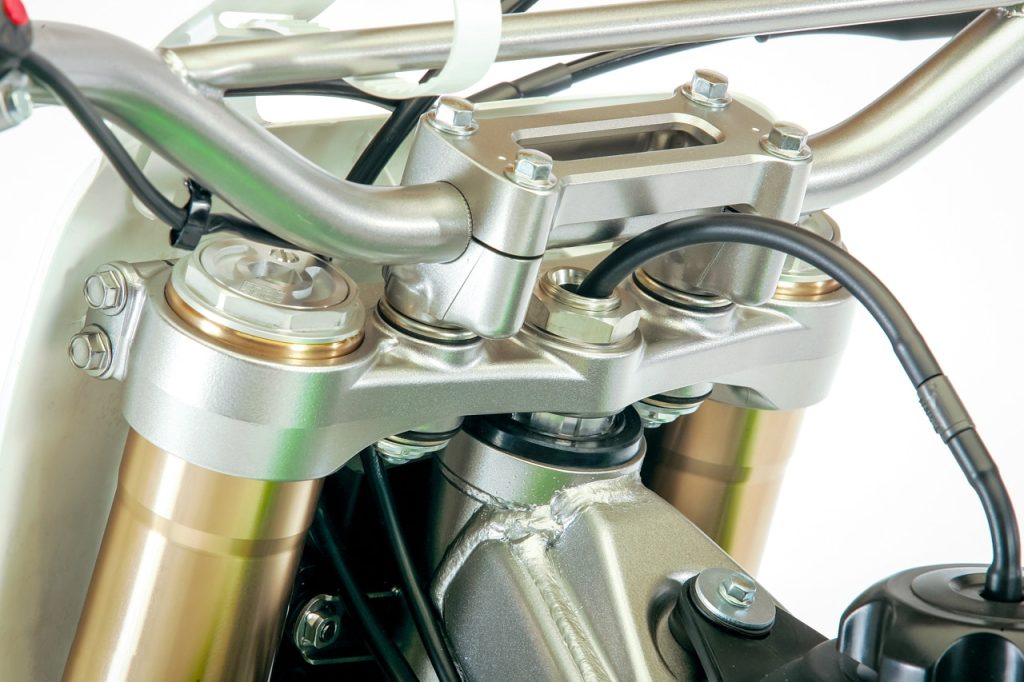 All-new clamps for 2005 positioned the bar mounts farther apart to prevent twisting in a crash. The mounts could also be reversed to increase room for taller pilots. While the clamps were state of the art, the stock steel bars the KX came fitted with most certainly were not. Photo Credit: Kawasaki
All-new clamps for 2005 positioned the bar mounts farther apart to prevent twisting in a crash. The mounts could also be reversed to increase room for taller pilots. While the clamps were state of the art, the stock steel bars the KX came fitted with most certainly were not. Photo Credit: Kawasaki
In terms of outward appearance, the 2005 KX250 looked very similar to the 2004 model, but the two machines shared very little aside from their styling. All-new in 2003, the KX’s bodywork carried over largely unchanged aside from a minor update in graphics, a 10mm taller seat (with gripper cover), and an enlarged filler hole for the fuel tank. Other than that, the 2005 KX looked like a near clone of the 2004 model.
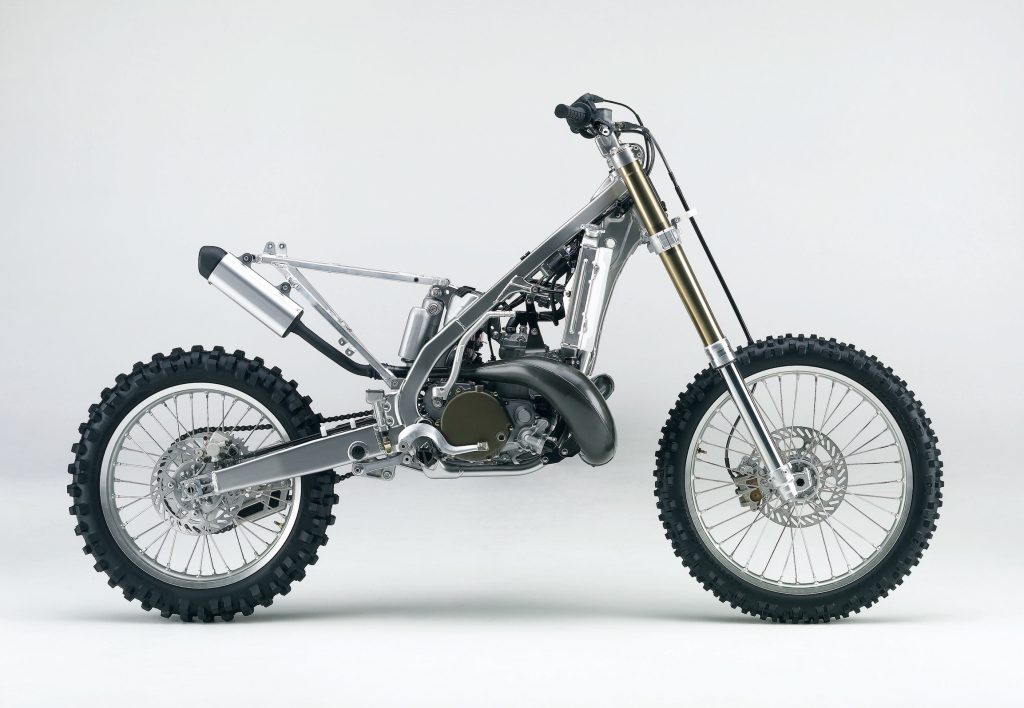 Aside from its retreaded bodywork, the KX250 was virtually all-new in 2005. Photo Credit: Kawasaki
Aside from its retreaded bodywork, the KX250 was virtually all-new in 2005. Photo Credit: Kawasaki
In truth, however, the 2005 KX250 chassis featured a long list of changes aimed at improving performance. First up was an all-new frame that retained the steel perimeter construction Kawasaki had employed since 1990. This design provided a strong and flex-free foundation for the chassis but had often been criticized for its girthy feel. In 2005, Kawasaki looked to address this by trimming the midsection of the machine and narrowing the width of the frame at the footpegs. The new frame featured a one-degree reduction in rake and a repositioning of the rear suspension mounting points to improve handling response. The new Uni-Trak employed a stronger swingarm for 2005 and a revised linkage aimed at reducing flex and improving tracking in the rough. While the swingarm was stronger, other parts of the frame were reduced in stiffness in an attempt to achieve the optimal “stiffness balance.” By repositioning the flex points of the chassis Kawasaki hoped to give the chassis a more responsive feel without sacrificing strength and stability.
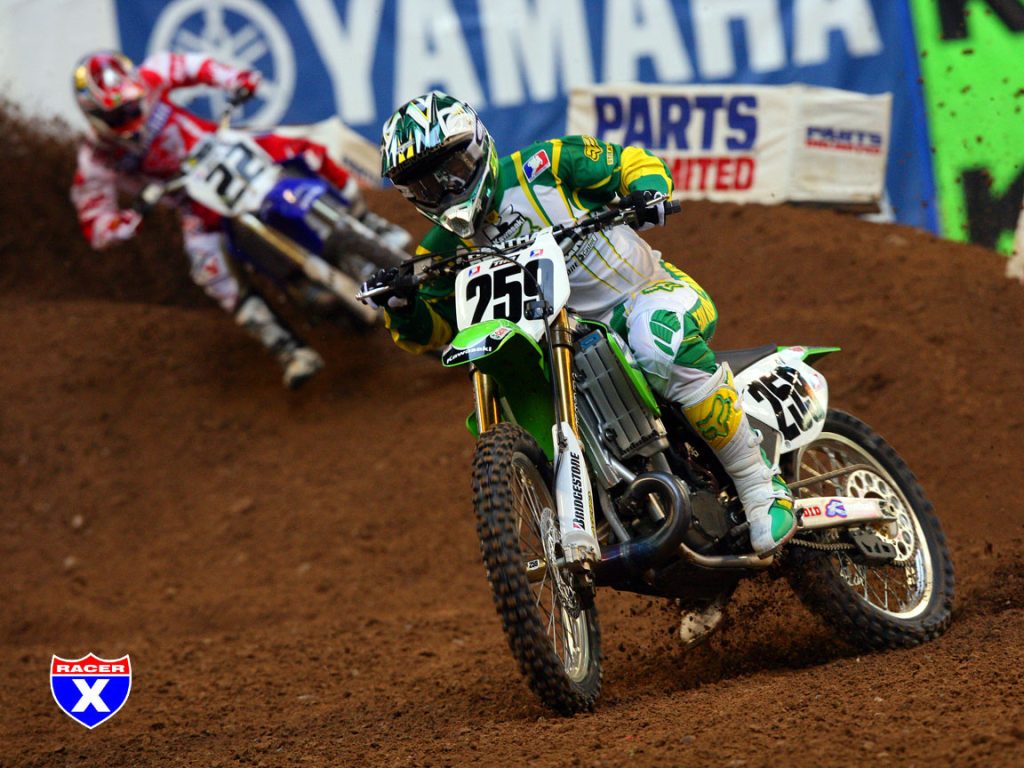 In supercross, the all-new KX250 gave 250 rookie sensation James Stewart the power he needed to run at the front. Photo Credit: Simon Cudby
In supercross, the all-new KX250 gave 250 rookie sensation James Stewart the power he needed to run at the front. Photo Credit: Simon Cudby
To reduce the chance of a rider catching their feet in ruts, both the brake pedal and footpeg mounts were repositioned higher on the frame and the pegs themselves were widened for an increased bite and improved comfort. New triple clamps were installed that moved the reversible bar mounts farther apart by 8mm for 2005. This was done to prevent the mounts from twisting in the event of a crash. While the bars remained steel in construction, a new bend was added to better work with the higher pegs and reshaped saddle for 2005. New lightweight rims and spokes shaved off a few ounces while beefed-up subframe mounts improved durability.
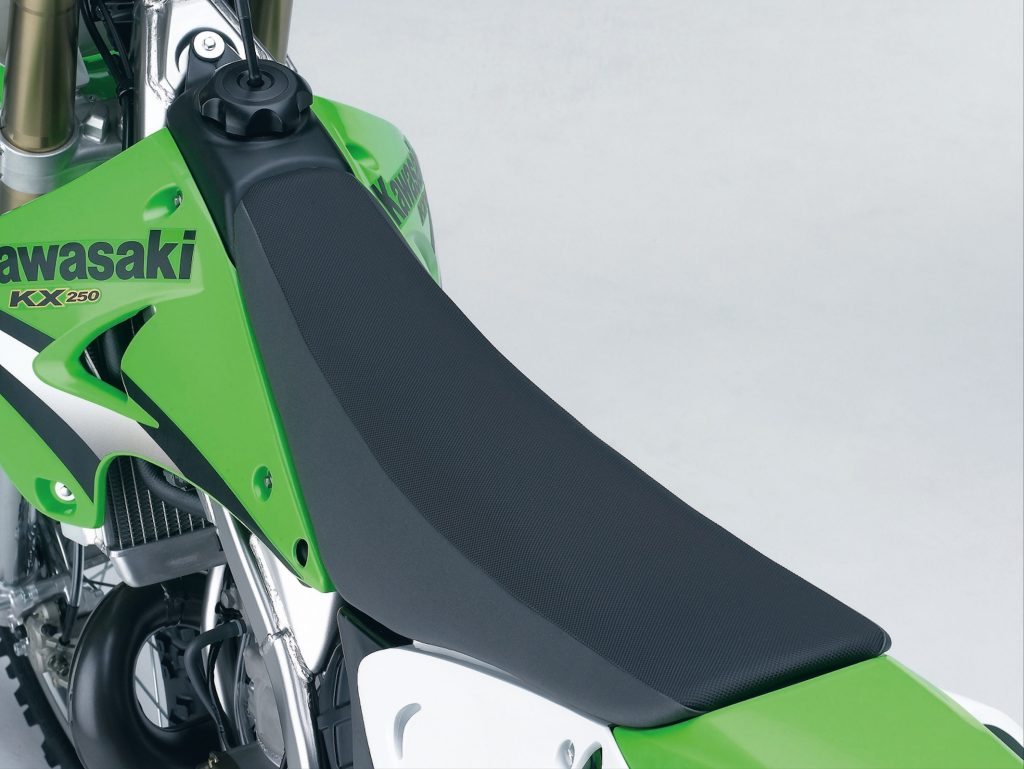 An all-new seat for 2005 featured a narrower profile, increased height, stiffer foam, and a non-slip cover for increased rider comfort. Photo Credit: Kawasaki
An all-new seat for 2005 featured a narrower profile, increased height, stiffer foam, and a non-slip cover for increased rider comfort. Photo Credit: Kawasaki
On the suspension front, the KX250 was all-new up front and moderately revamped in the rear. New forks for 2005 upgraded the suspension performance by moving to Kayaba’s new Air Oil Separation System (AOSS) that separated the air and oil chambers to prevent frothing of the fluid. Similar in concept to Showa’s Twin-Chamber design, the AOSS fork offered improved damping, reduced fade, and a reduction in stiction through the use of special low-friction seals. For 2005, these 48mm inverted units offered 11.8 inches of wheel travel with 16 external adjustments available for compression and rebound damping.
 After several years of mild-mannered KX250s, the green team came roaring back with a major powerhouse in 2005. The new motor pumped out four more horsepower than the 2004 and delivered a brutal midrange hit that blasted the KX out of every corner While not as easy to manage as the 2004, most serious racers found the new mid-and-up motor preferable to the friendlier but less-thrilling older design. Photo Credit: Kawasaki
After several years of mild-mannered KX250s, the green team came roaring back with a major powerhouse in 2005. The new motor pumped out four more horsepower than the 2004 and delivered a brutal midrange hit that blasted the KX out of every corner While not as easy to manage as the 2004, most serious racers found the new mid-and-up motor preferable to the friendlier but less-thrilling older design. Photo Credit: Kawasaki
In the rear, the Uni-Trak rear suspension featured a new ratio for the linkage and a beefed-up swingarm as its most significant updates. The Kayaba shock remained largely unchanged from 2004 with new damping settings to match the revised linkage curve being the most noteworthy update. Like the forks, the KYB damper offered 16 external adjustments for compression and rebound damping. As in 2004, it lacked the high-low speed compression adjuster of previous KXs and many of its rivals.
 With all that power on tap and an explosive delivery, the 2005 KX250 could be a real handful in slippery conditions. Photo Credit: Steve Bruhn
With all that power on tap and an explosive delivery, the 2005 KX250 could be a real handful in slippery conditions. Photo Credit: Steve Bruhn
On the track, the KX250 was a whole new animal in 2005. The redesigned motor was head-and-shoulders better than in 2004 and thoroughly in the running for the best two-stroke 250 motor of the year. On the dyno, it pumped out four more horsepower than the year before and did so with a much more aggressive delivery. In ‘04, the KX had offered a smooth and mellow delivery that beginners and off-road guys loved but moto heads found lacking. For 2005, that was no longer a concern with the redesigned motor delivering a barking and snarling style of power that blasted out of turns and sent rooster tails flying. The new power plant gave up a good bit of low-end grunt to the older KX but made up for it with an explosive mid-range hit and blistering top-end pull. Once on the pipe, the KX was an absolute rocket and capable of hanging with anything in the class. With its soft low-end and abrupt midrange, the KX could be a handful if traction was limited, however. On hard and slick surfaces, the green machine tended to light up the rear tire, and here the smoother and torquier YZ250 had an advantage. As with previous KX250s, the clutch and transmission lacked some of the finesse of its rivals and this compounded the difficulty in transferring the Kawasaki’s prodigious power to the ground. Shifting remained slightly notchy and the clutch’s engagement continued to be grabby despite the new cable and mechanism. It was a motor that longed for traction and rewarded aggression but also penalized those without the skill to harness its potential.
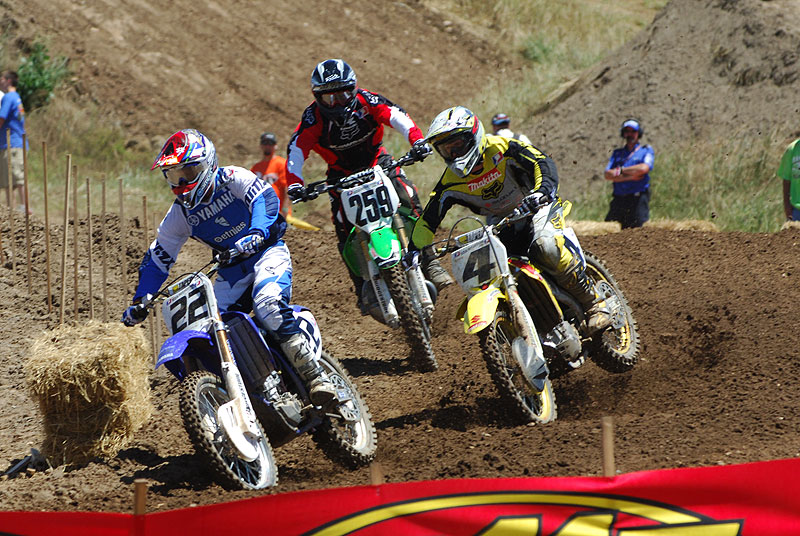 Indoors, the KX250 was more than capable of running with its 250 rivals, but outdoors, the move to 450 four-strokes left Stewart and the green team at a distinct disadvantage. Photo Credit: Vital MX
Indoors, the KX250 was more than capable of running with its 250 rivals, but outdoors, the move to 450 four-strokes left Stewart and the green team at a distinct disadvantage. Photo Credit: Vital MX
In the hierarchy of 2005 250 two-stroke powerbands, the new KX250 fit somewhere right between the lighting fast RM and broad YZ. It was significantly faster than the Honda, harder to ride than the Yamaha, and almost as quick as the Suzuki. This made it by far the most competitive Kawasaki 250 power package in half a decade and finally a match for its rivals. With the four-stokes overtaking the class, that competitive benchmark was quickly moving, but for the time being, the KX was a powerband contender.
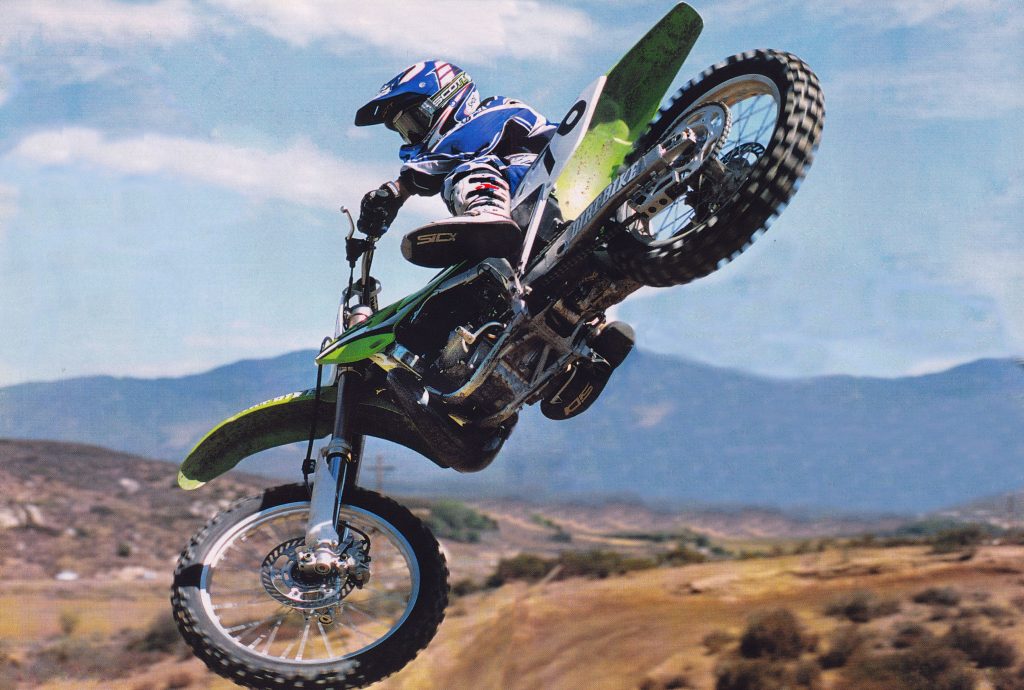 At 226 pounds, the KX250 was the heftiest of all the 250 two-strokes and only 5 pounds shy of Honda’s popular CRF450R. While the power characteristics and lower reciprocating mass of the two-stroke made that difference feel larger, there was no denying the fact that the KX was not as feathery feeling as its 250 competition. Photo Credit: Dirt Bike
At 226 pounds, the KX250 was the heftiest of all the 250 two-strokes and only 5 pounds shy of Honda’s popular CRF450R. While the power characteristics and lower reciprocating mass of the two-stroke made that difference feel larger, there was no denying the fact that the KX was not as feathery feeling as its 250 competition. Photo Credit: Dirt Bike
On the handling front, the KX offered a middle-of-the-road handling package that skewed toward stability rather than corner-shredding nimbleness. The new frame did not change the KX’s personality and the machine remained the same large and long-feeling bike it had been for more than a decade. Tall riders enjoyed this roomy layout, but smaller riders commented on the heftier feel the KX imparted. This feeling was borne out on the scale with the KX clocking in at a relatively portly 226 pounds. That was 13 pounds heavier than the lightweight KTM and only five pounds shy of Honda’s CRF450R four-stroke. While this gave the KX a planted and solid feel at speed, it did hinder its nimbleness in the tighter sections of the track. Here, the KX felt noticeably less willing to be thrown around than featherweights like Honda’s 218-pound CR250R. The new steeper geometry did little to dispel the KX’s vague feel at turn-in and many riders found the Kawasaki to be unpredictable in the turns. Sometimes it oversteered, and sometimes it understeered with the front wheel searching for a bite. Some of this probably had to do with the chassis’ balance which was skewed too heavily toward the front. With the stock linkage in place, the rear of the machine was jacked to the moon giving it a very “front heavy” feel. The quickest fix for this was an aftermarket link that lowered the rear of the bike and balanced out the chassis. This improved turning but the KX remained less precise than its rivals at hunting the inside line.
 The KX’s new forks offered a significant improvement in ride comfort over the “semi sealed cartridge” fork employed in 2004. The new AOSS design offered a smooth and compliant ride that gobbled up braking bumps and made small chatter disappear. Bottoming was an issue for really fast guys, but most riders loved the feel of the new front end. Photo Credit: Kawasaki
The KX’s new forks offered a significant improvement in ride comfort over the “semi sealed cartridge” fork employed in 2004. The new AOSS design offered a smooth and compliant ride that gobbled up braking bumps and made small chatter disappear. Bottoming was an issue for really fast guys, but most riders loved the feel of the new front end. Photo Credit: Kawasaki
While the stock KX was not particularly great in the turns, it was admirably stable at speed. There was none of the hyperactive feel the Suzuki exhibited and a KX generally followed its intended path with little drama. Headshake was minimal and the KX could be trusted to track straight and true through most high-speed sections.
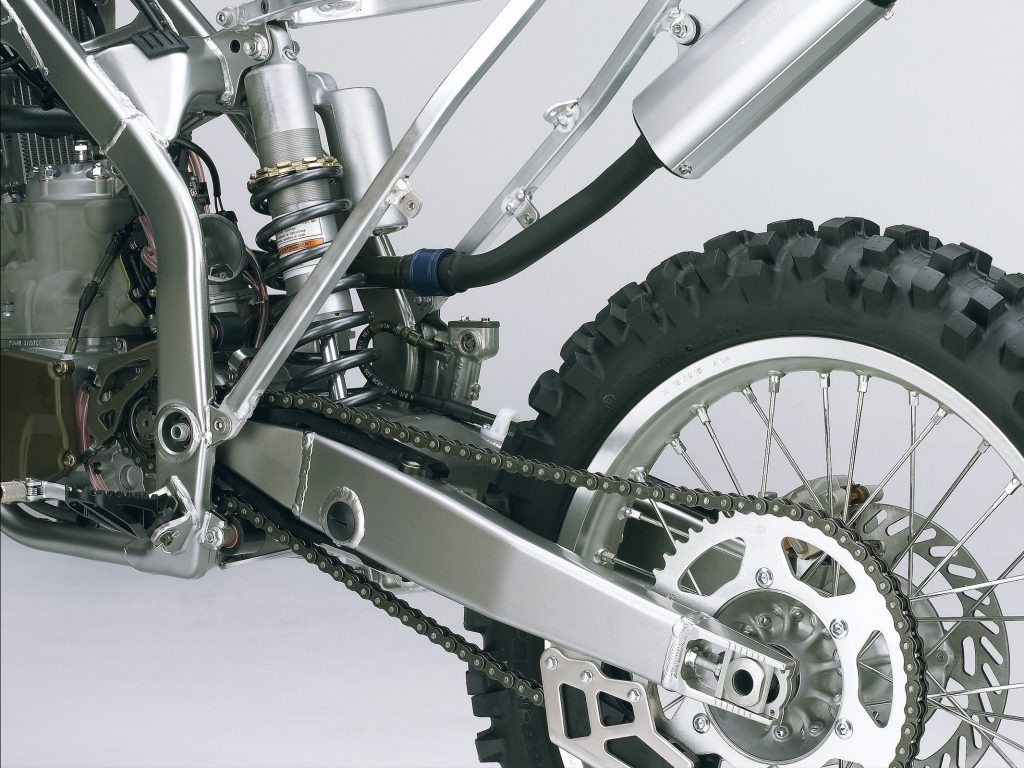 By far the biggest complaint most riders had with the KX in 2005 was its stock chassis balance. The combination of the new linkage and soft front forks gave the bike a strong forward bias that played havoc with its handling feel. Stiffer front springs and an aftermarket link were the quickest fixes to even out the KX and get the best performance out of its chassis. Photo Credit: Kawasaki
By far the biggest complaint most riders had with the KX in 2005 was its stock chassis balance. The combination of the new linkage and soft front forks gave the bike a strong forward bias that played havoc with its handling feel. Stiffer front springs and an aftermarket link were the quickest fixes to even out the KX and get the best performance out of its chassis. Photo Credit: Kawasaki
Some of that high-speed confidence was certainly due to the KX’s excellent suspension which provided a smooth and compliant ride on the track. The new AOSS fork offered very little stiction and provided a great feel on small bumps and chatter. Overall settings were slightly softer than the very similar fork found on the Yamaha YZ250, and this helped contribute to the KX’s front-heavy bias. Some faster riders also complained of bottoming on large jumps and a strange “clunk” sound which could be heard when maxing out their travel. Thankfully, however, the bottoming system did a good job of isolating the rider from any harsh jolts at the bars. Whoops, bumps and moderately sized jumps were all taken in stride and the forks generally did a great job of going about their business. Bigger and faster riders needed stiffer settings but for the majority of riders, they were excellent performers in stock condition.
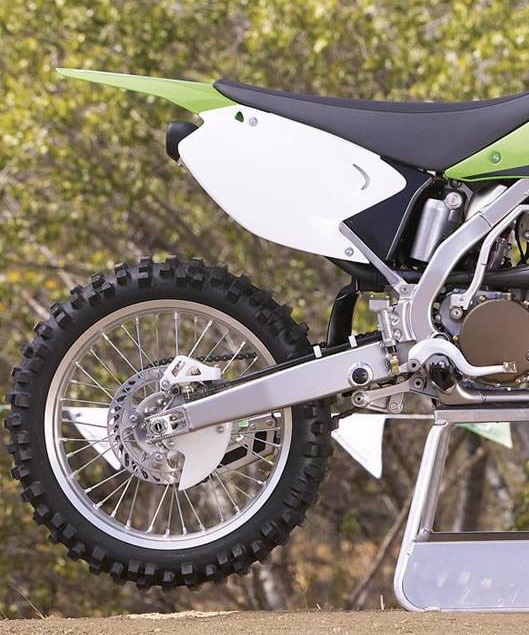 In stock condition the rear suspension on the 2005 KX250 was a solid performer. The overall feel was firmer than in 2004 and it took most big hits with nary a whimper. Photo Credit: Kawasaki
In stock condition the rear suspension on the 2005 KX250 was a solid performer. The overall feel was firmer than in 2004 and it took most big hits with nary a whimper. Photo Credit: Kawasaki
Out back, the KX’s new suspension provided a slightly firmer feel than the previous KX250. While firmer than in 2004, it remained softer overall than many of its rivals. This translated to a plush feel on most obstacles and a smooth ride in the rough. With the stock linkage in place, there was the occasional kick under acceleration, but the aftermarket link that balanced out the chassis also alleviated much of this by changing the leverage ratio to prevent the shock from dropping so far down into its stroke under power. Even with the stock link in place, however, it was a plush and mostly well-sorted rear end.
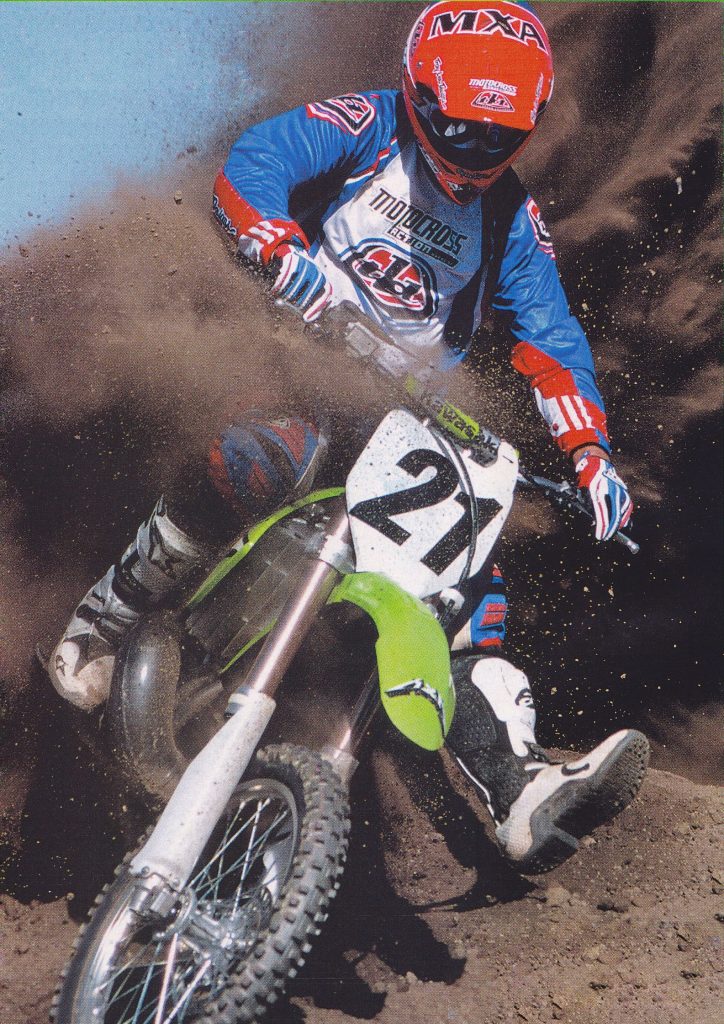 Overall handling was less precise than most of its rivals but the KX had more than enough thrust to power its way out of tight turns in 2005. Photo Credit: Motocross Action
Overall handling was less precise than most of its rivals but the KX had more than enough thrust to power its way out of tight turns in 2005. Photo Credit: Motocross Action
On the detailing front, the KX remained a mix of appreciated improvements and head-scratching disappointments in 2005. On the thumbs-up list were new brakes which offered a significant improvement in feel, Teflon-coated cables for smoother action, sano pipe coating, larger fuel filler, upgraded bar mounts, taller and stiffer seat foam, non-slip seat cover, and a three-pound reduction in weight. In the thumbs-down category were the KX’s old-school steel bars, a weird habit of painting their swingarms black and then silver, grabby clutch, notchy shifting, and still disappointing weight. Many riders included the KX’s stale looks in this category as well, feeling such a significant upgrade in performance warranted at least a mild update in looks. At least the bike was handsome, aside from its skyward-pointing rear end.
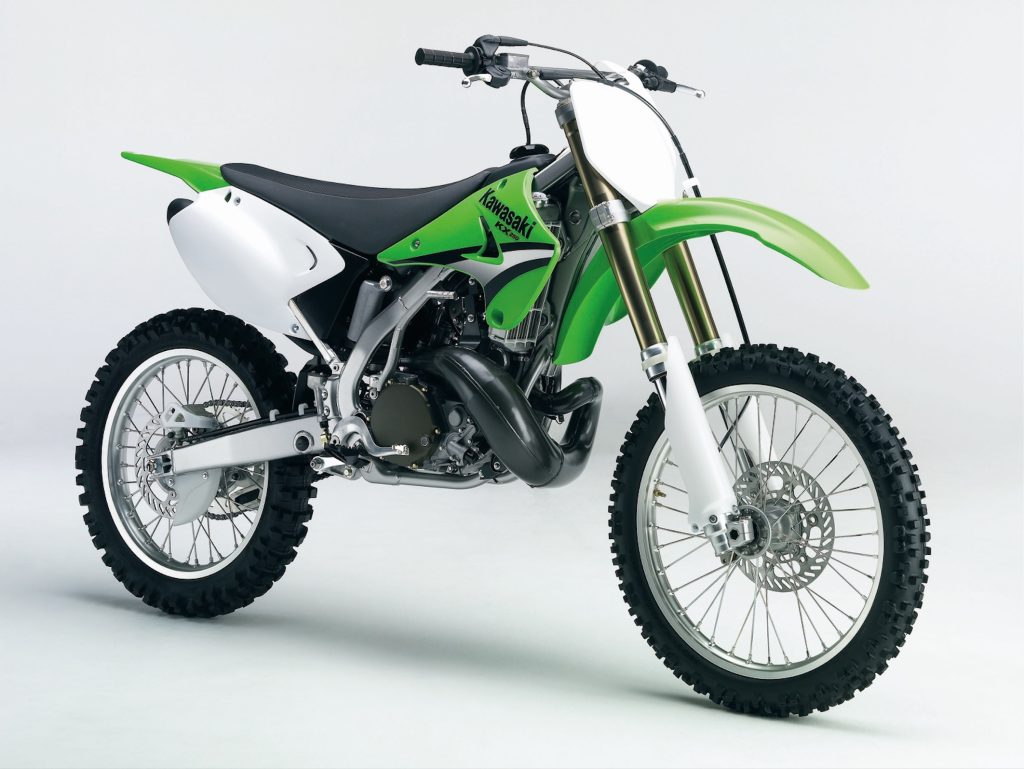 Finally fast, the KX250 offered an aggressive package in need of a little fine-tuning in 2005. Photo Credit: Kawasaki
Finally fast, the KX250 offered an aggressive package in need of a little fine-tuning in 2005. Photo Credit: Kawasaki
Overall, the 2005 Kawasaki KX250 turned out to be a significant improvement in nearly every category of motocross performance. With its blazing fast motor, the KX finally had the firepower to take on its 250 rivals, but it did demand more skill to get that power to the ground. The new forks, improved ergonomics, upgraded brakes, and reinvigorated power plant turned an also-ran into an instant contender. The jacked-up rear, cranky transmission, large feel, and demanding power held it back from being a unanimous choice for the top 250 in the land, but for those with the skill to harness its potential, the 2005 KX250 was an extremely effective motocross weapon.
For your daily dose of classic moto, you can follow me @tonyblazier on Twitter and Instagram.


